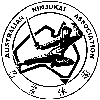|
|
The Syllabus
<- Back to About Ninjukai
For more information on techniques studied, see Training Ninjukai
Ninjukai Taijutsu is NOT about katas, championships or personal glory. It is about what Martial Art traditionally was all about: a life-long journey towards self realisation and personal growth. The practitioner seeks the balance and harmony that is necessary to experience the spontaneity and flow of his techniques. For he knows that life is about random situations, NOT set situations.
The Oshima system of traditional Taijutsu is a style that resembles as closely as possible the fighting system used by the ancient Ninja. Much of the original techniques and fighting methods of the ancient Ninja have been retained. The World Ninja Society was formed to preserve this very system and prevent its adulteration, dilution, or commercialisation.
Ninjukai Taijutsu is the rarest and most lethal martial art in the world. All aspects of armed and unarmed combat are taught. The training strictly follows the classical NINJUKAI Taijutsu syllabus, from 8th Kyu Yellow Belt to the coveted 3rd Dan Black Belt. Compared with other martial arts, a Ninjukai student receives the most robust and rigorous training - and only the toughest can reach the Black Belt. Spiritual training and meditation form an important part of the syllabus.
The syllabus includes the following :
- Omasajutsu (weight & Strength training)
- Taihenjutsu (grappling, throwing & choking)
- Dakenjutsu (strikes, kicks & blockings)
- Shinobi iri (situation techniques)
- Bojutsu (ninja 6ft. staff)
- Hanbojutsu (ninja 3ft. staff)
- Saijustsu (sai techniques)
- Juttejutsu (jutte technique)
|
- Jojutsu (ninja 4ft. staff)
- Kenjutsu (ninja sword techniques)
- Tantojutsu (ninja knife technique)
- Kamajutsu (ninja sickle technique)
- Wakizashijutsu (Short sword technique)
- Tonfajutsu (ninja baton technique)
- Manrikijutsu (flexible chain technique)
|
Rankings in Ninjukai Taijutsu reflect the three stages in one's experiences in the Art. This is known as SHU-HA-RI in Japanese.
THE SHU STAGE
The first stage of SHU involves the learning process, whereby the
student learns all the basics in techniques. Although at this level he
learns through techniques, nonetheless he understands that he must not
allow what he has learned to stay but to be able to "unlearn" when he
comes to the next level of HA. It must be understood that one has to
'learn' before he can 'unlearn'. The student starts the SHU journey at the White Belt and finishes the journey at the Red Belt.
|

|
The Yellow Belt Syllabus
The start of the journey: One gets to know one's own body. The student learns through his own body the meaning of balance and stances. While learning the importance of stability through good stances, at the same time he learns how to fall.
Breakfalling and rolling techniques are taught. The student is also introduced to techniques at varying combat ranges - striking ranging, kicking range, grappling range and throwing range. Students who finished this syllabus will therefore have knowledge in basic kicks, strikes, locks and throws besides a background of breakfalls and rolls. The Yin aspect of the Art is also taught at this stage. Chi and breathing techniques are shown. |
The Orange Belt Syllabus
This is a follow-up level. The student starts to appreciate the significance of fighting ranges. A technique is only useful if you can get the opponent within the correct range. You will not use a flying thrust kick against an opponent who attacks you while you are making a phone call in a telephone booth. The student starts to understand that there are different techniques for different ranges. The student is exposed to more throwing techniques, kicks (including side thrust kicks and various knee kicks), hand strikes (including elbow strikes), locking and grappling techniques. |
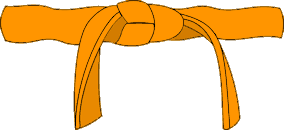
|
|
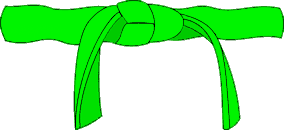
|
The Green Belt Syllabus
A level of creativity and spontaneity is introduced at this level. The importance of footwork is recognized as the student starts to introduce movements into his punches and kicks. Everything in nature is in a state of movement. Likewise when one faces an opponent it is a tale of two moving objects - you and him. One realizes that in a real life situation one has to learn to acquire the ability to execute techniques "in motion". It is not sufficient to be able to deliver a hard strike at a static punchbag or to break ten tiles in one blow. Your opponent is unlikely to remain static waiting for you to chop him up in two. It is more likely that he is in a state of motion and so are you. |
The Blue Belt Syllabus
At this level one starts to understand more of the 3Ms of Momentum, Motion and Mass. The student realizes that good footwork is necessary for good stances. And good stances in turn will allow good techniques. From here one moves on to have a better understanding of what sparring means. Ninjukai Taijutsu is NOT a ring sport with set rules, so in sparring you must train to be prepared for any eventuality. In real life your opponent observes no guidelines when he attacks you. Also at this level the student is first introduced to weaponry. He learns the long Japanese sword, the Katana. The sword is looked upon as a natural extension not only of the arm that holds it, but of the mind as well. The principle of Ki-Ken-Tai-Ichi or the unity of the mind and body with the Sword is taught to the student. |
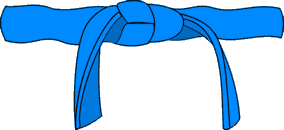
|
|
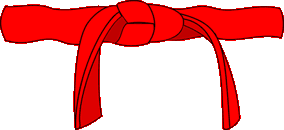
|
The Red Belt Syllabus
The student covers more weapons at this level the ancient
weapons of Kama and Bo (six-foot staff) are taught. The student also
moves on to Level 2 of Sparring and Level 2 of Swordsmanship. In
Level 2 Sparring he knows the importance of creating an 'opening' in
order to allow his techniques to find their target quickly.
Techniques against your opponents are not confined to punches and
kicks; throws and locking techniques are equally important. As one
progresses on to the more advanced SHU Level, meditational practices become more important. Meditation becomes an integral aspect of one's training. |
The Purple Belt Syllabus
On completion of this syllabus the student ends the SHU journey. So before he ends his journey he takes a closer look at the Yang aspect of the Art. He trains in more weapons - including the Sai and the Jo (a 4-feet wooden staff) and the Tanto (knife). He also starts to have a better comprehension of the spirituality of the Katana or Sword when he learns the formality involved in the Naka-Zuki
Bow. He moves on to Level 3 of sparring and appreciates more the necessity to be spontaneous in meeting opposing forces. One cannot afford to be rigid in sparring. Wrestling techniques are also taught - as students start to realize that a fighting situation can easily take both you and your opponent on to the ground. |

|
THE HA STAGE
This is basically the "unlearning" stage. In HA the student experiences the limitations of techniques. He starts to realize that techniques are of not much use by themselves. All techniques are relative - and the student starts to realize the importance of the environment. Techniques can only be useful if the student can relate them to his surroundings. Techniques that work under set circumstances in the dojo or the ring will lose their relevance in a different environmental setting. The HA level is the level where the student is expected to undergo a degree of transformation. He learns and understands that spontaneity is the key to unlock the rigidity and inflexibility of techniques. He slowly learns to go beyond the limitations of techniques. Once a student obtains the Purple Belt he begins the Brown belt Syllabus - and it is here that he commences his HA journey. The Ha journey ends at the 3rd Dan.
|

|
The Brown Belt Syllabus
This level signals the commencement of the HA journey. The First Stage of "unlearning" begins. One begins to see the futility of the process of learning - it limits your growth and inhibits spontaneity. While it is impossible to learn 'everything' yet in life we must be prepared to face 'anything' The student therefore meditates often to find himself; to allow the inner self to open out so that spontaneity can flow. This is important because from now on he learns not to look at techniques just as a method to counter a situation, but as a necessary and spontaneous energy to meet an opposing force. He goes on to experience more weapons including the
Manriki Gusari, the Hanbo (a 3-feet staff) and the Wakizashi (a short Japanese sword) |
The Shodan Syllabus
The student further unlearns in this second stage of the "unlearning process". Sparring and other forms of unarmed combat take on a different dimension. Punches, kicks, throws or locks are just movements of the body. These movements are then categorized and given labels. These categories of movements, known as techniques are of no use by themselves unless one can relate them to the opponent. And these techniques must never be rigid - they have to bend and blend with the opponent's force. Similar understanding must apply to weaponry as the student learns the
Tonfa (short Japanese baton), and the Jutte. |
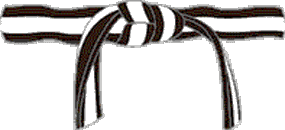
|
|
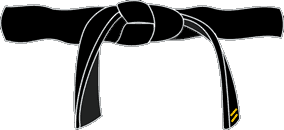
|
The Nidan Syllabus
The student by now would have a better spiritual understanding of himself. Through frequent meditation he appreciates the inseparability of mind and body. More and more he understands the limitations of techniques. Techniques are learned under 'set conditions' and it is therefore quite natural for the mind to start accepting these set conditions as a necessary prelude before techniques can be executed. At this level therefore the student starts to study the environment first because he realizes that it is the environment (or situation) that determines the techniques. |
The Sandan Syllabus
This the last phase of the HA journey. Through the "unlearning" process the student cultivates an awareness of the limitations of his techniques. He now sees techniques as spontaneous manifestations of the mind rather than a set of movements to be learned and remembered. He becomes proficient in the doctrine of 'seiryoku zenyo' - the use of minimum energy for any situation. He has learned the art of 'blending' (instead of opposing) his energy with opposing forces. |
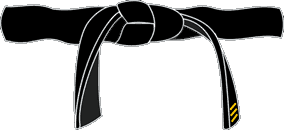
|
|
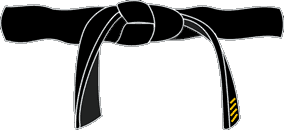
|
THE RI STAGE
From the 4th Dan onwards one travels the RI path - a path of transcendence when one frees oneself from all techniques. In one's mind techniques do not exist as techniques. The source of techniques (which is your mind) and techniques are one and the same. It is no longer a situation of YOU and TECHNIQUES. You are the techniques. The techniques and you are ONE - no longer separable. At this level the student has finally found 'freedom'. He sees the world as 'Universal Chi' and harmony can only come about when one finds balance with that energy. |
For more information on techniques studied, see Training Ninjukai
<- Back to About Ninjukai
|
